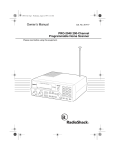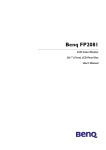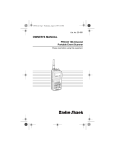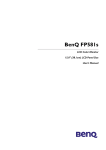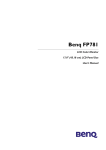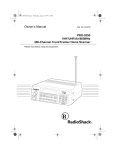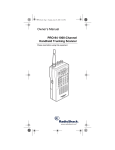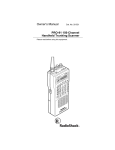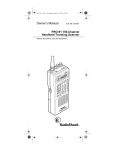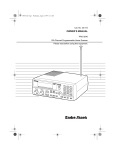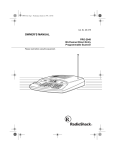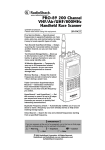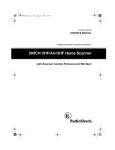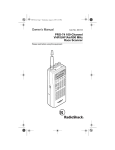Download Radio Shack 200 Owner`s manual
Transcript
20-418.fm Page 1 Wednesday, August 4, 1999 12:42 PM Cat. No. 20-418 OWNER’S MANUAL PRO-2045 200-Channel Weather Alert Home Scanner Please read before using this equipment. 20-418.fm Page 2 Wednesday, August 4, 1999 12:42 PM FEATURES Your RadioShack PRO-2045 200Channel Weather Alert Home Scanner lets you in on all the action! This scanner gives you direct access to over 49,500 exciting frequencies used by police and fire departments, ambulance and transportation services, amateur radio, as well as aircraft communications, Citizen’s Band, and commercial FM and television broadcasts. You can select up to 200 channels for your scanner to scan, and you can change your selections at any time. Its rotary tuning control lets you easily select frequencies and channels. Plus, when you turn on the weather alert function, the scanner sounds an alarm if the weather service transmits a weather alert tone. Hyperscan — scans programmed channels at up to 50 channels per second. Hypersearch — lets you set the scanner to search at up to 300 steps per second. Rotary Tuner — lets you easily tune and select frequencies or channels. Auto Sort — lets you scan the channels stored in a bank, in order from lowest to highest frequency, to increase scanning speed. Auto Store — quickly finds and automatically stores active frequencies into the selected banks (but does not store the frequency if it is already stored in another channel). The secret to your scanner’s ability to scan so many frequencies is its custom-designed microprocessor — a tiny, built-in computer. Ten Channel-Storage Banks — let you store 20 channels in each of 10 banks to group frequencies so you can easily identify calls. Your scanner has these features: Frequency Transfer — lets you easily organize your frequencies by transferring them from one channel to another. WX Alert — warns you of serious weather conditions by sounding an alarm if the weather service transmits a weather alert tone. Weather Band Auto Scan — scans the preprogrammed weather frequencies so you can stay informed about current weather conditions. Monitor Memories — let you store up to 10 frequencies you locate during a frequency search. Limit Search — lets you search for transmissions within a set range. © 1996 Tandy Corporation. All Rights Reserved. RadioShack is a trademark used by Tandy Corporation. Hyperscan and Hypersearch are registered trademarks used by Tandy Corporation. 2 20-418.fm Page 3 Wednesday, August 4, 1999 12:42 PM Direct Search — lets you search for transmissions starting from a frequency you specify. Attenuator — reduces the scanner’s sensitivity to help limit reception to strong, nearby transmitters. Count Feature — lets you keep track of how many times your scanner has stopped on a channel. Memory Backup — keeps stored channel frequencies in memory for up to 3 days during a power loss. Search Skip — lets you select up to 50 frequencies for the scanner to skip during a search, so you can avoid frequencies you have already discovered or that have a continuous transmission. CTCSS Option — with an optional CTCSS tone circuit board, you can use the Continuous Tone Coded Squelch System (CTCSS) to selectively listen to some business band and amateur radio transmissions. Two-Second Scan Delay — delays scanning for 2 seconds before moving to another channel, so you can hear more replies. Backlit Display — lets you easily see the indicators on the scanner’s display, even at night. Data Skip — skips data signals (nonmodulated signals such as preamble signals for pagers) during scan, limit search, and direct search. Lock-Out Function — prevents channels you select from being scanned. Priority Channels — checks 10 specified channels every 2 seconds so you do not miss important calls. We recommend you record your scanner’s serial number here. The number is on the scanner’s back panel. Serial Number: _________________ Your scanner has the following preprogrammed weather channels: • 162.4000 MHz (NFM) • 162.4250 MHz (NFM) • 162.4500 MHz (NFM) • 162.4750 MHz (NFM) Automatic Modulation Mode — selects the modulation method — narrow-band frequency modulation (NFM) or amplitude modulation (AM) — most often used for each band, and lets you manually override the preset mode. • 162.5000 MHz (NFM) • 162.5250 MHz (NFM) • 162.5500 MHz (NFM) 3 20-418.fm Page 4 Wednesday, August 4, 1999 12:42 PM Your scanner can receive all of these bands: Range (MHz) Step (kHz) Mode 29–54 5 NFM 108–136.975 12.5 AM 137–174 5 NFM 216–224.9875 12.5 NFM 225–399.9875 12.5 AM 400–512 12.5 NFM 806–823.9375 12.5 NFM 851–868.9375 12.5 NFM 896.1125–1,000 12.5 NFM FCC NOTICE Your scanner might cause radio or TV interference even when it is operating properly. To determine if your scanner is causing the interference, turn off your scanner. If the interference goes away, your scanner was causing it. Try to eliminate the interference by: • Moving your scanner away from the receiver • Connecting your scanner to an outlet that is on a different electrical circuit from the receiver • Contacting a RadioShack store for help If you cannot eliminate the interference, the FCC requires that you stop using your scanner. 4 SCANNING LEGALLY Your scanner covers frequencies used by many different groups including police and fire departments, ambulance services, government agencies, private companies, amateur radio services, military operations, pager services, and wireline (telephone and telegraph) service providers. It is legal to listen to almost every transmission your scanner can receive. However, there are some transmissions you should never intentionally listen to. These include: • Telephone conversations (either cellular, cordless, or other private means of telephone signal transmission) • Pager transmissions • Any scrambled transmissions or encrypted According to the Electronic Communications Privacy Act (ECPA), you are subject to fines and possible imprisonment for intentionally listening to, using, or divulging the contents of such a transmission unless you have the consent of a party to the conversation (unless such activity is otherwise illegal). RadioShack encourages responsible, legal scanner use. 20-418.fm Page 5 Wednesday, August 4, 1999 12:42 PM CONTENTS Preparation . . . . . . . . . . . . . . . . . . . . . . . . . . . . . . . . . . . . . . . . . . . . . . . . . . . . . . 7 Connecting Power . . . . . . . . . . . . . . . . . . . . . . . . . . . . . . . . . . . . . . . . . . . . . . 7 Using Standard AC Power . . . . . . . . . . . . . . . . . . . . . . . . . . . . . . . . . . . . 7 Using Vehicle Battery Power . . . . . . . . . . . . . . . . . . . . . . . . . . . . . . . . . . 7 Connecting an Antenna . . . . . . . . . . . . . . . . . . . . . . . . . . . . . . . . . . . . . . . . . 8 Telescoping Antenna . . . . . . . . . . . . . . . . . . . . . . . . . . . . . . . . . . . . . . . . 8 Optional Outdoor Antenna . . . . . . . . . . . . . . . . . . . . . . . . . . . . . . . . . . . . 8 Resetting the Scanner . . . . . . . . . . . . . . . . . . . . . . . . . . . . . . . . . . . . . . . . . . 9 Using the Feet . . . . . . . . . . . . . . . . . . . . . . . . . . . . . . . . . . . . . . . . . . . . . . . . . 9 Testing Alert Operation . . . . . . . . . . . . . . . . . . . . . . . . . . . . . . . . . . . . . . . . . 10 Testing Alert Reception . . . . . . . . . . . . . . . . . . . . . . . . . . . . . . . . . . . . . . 10 Testing the Weather Alert . . . . . . . . . . . . . . . . . . . . . . . . . . . . . . . . . . . . 11 Connecting an Earphone . . . . . . . . . . . . . . . . . . . . . . . . . . . . . . . . . . . . . . . 11 Listening Safely . . . . . . . . . . . . . . . . . . . . . . . . . . . . . . . . . . . . . . . . . . . 11 Traffic Safety . . . . . . . . . . . . . . . . . . . . . . . . . . . . . . . . . . . . . . . . . . . . . . 12 Connecting an Amplified Extension Speaker . . . . . . . . . . . . . . . . . . . . . . . . 12 Installing an Optional CTCSS Tone Board . . . . . . . . . . . . . . . . . . . . . . . . . . 12 Understanding Your Scanner . . . . . . . . . . . . . . . . . . . . . . . . . . . . . . . . . . . . . . A Look at the Keyboard . . . . . . . . . . . . . . . . . . . . . . . . . . . . . . . . . . . . . . . . A Look at the Display . . . . . . . . . . . . . . . . . . . . . . . . . . . . . . . . . . . . . . . . . . Understanding Channel-Storage Banks . . . . . . . . . . . . . . . . . . . . . . . . . . . . Channel-Storage Banks . . . . . . . . . . . . . . . . . . . . . . . . . . . . . . . . . . . . . Monitor Memories . . . . . . . . . . . . . . . . . . . . . . . . . . . . . . . . . . . . . . . . . . 14 14 16 18 18 18 Operation . . . . . . . . . . . . . . . . . . . . . . . . . . . . . . . . . . . . . . . . . . . . . . . . . . . . . . Turning On the Scanner/Setting Volume and Squelch . . . . . . . . . . . . . . . . . Using the Rotary Control . . . . . . . . . . . . . . . . . . . . . . . . . . . . . . . . . . . . . . . . Storing Frequencies . . . . . . . . . . . . . . . . . . . . . . . . . . . . . . . . . . . . . . . . . . . Searching For and Temporarily Storing Active Frequencies . . . . . . . . . . . . . Limit Search . . . . . . . . . . . . . . . . . . . . . . . . . . . . . . . . . . . . . . . . . . . . . . Direct Search . . . . . . . . . . . . . . . . . . . . . . . . . . . . . . . . . . . . . . . . . . . . . Search Skip . . . . . . . . . . . . . . . . . . . . . . . . . . . . . . . . . . . . . . . . . . . . . . Automatically Storing Frequencies . . . . . . . . . . . . . . . . . . . . . . . . . . . . . . . . Listening to Monitor Memories . . . . . . . . . . . . . . . . . . . . . . . . . . . . . . . . . . . Moving a Frequency from a Monitor Memory to a Channel . . . . . . . . . . . . . Scanning Channels . . . . . . . . . . . . . . . . . . . . . . . . . . . . . . . . . . . . . . . . . . . . Turning Channel-Storage Banks On and Off . . . . . . . . . . . . . . . . . . . . . Locking Out Channels . . . . . . . . . . . . . . . . . . . . . . . . . . . . . . . . . . . . . . Manually Selecting a Channel . . . . . . . . . . . . . . . . . . . . . . . . . . . . . . . . . . . Scanning the Weather Band . . . . . . . . . . . . . . . . . . . . . . . . . . . . . . . . . . . . . Weather Alert . . . . . . . . . . . . . . . . . . . . . . . . . . . . . . . . . . . . . . . . . . . . . Using the Weather Alert Standby Mode . . . . . . . . . . . . . . . . . . . . . . . . . 19 19 19 19 20 20 21 22 23 24 24 24 24 25 25 26 26 26 5 20-418.fm Page 6 Wednesday, August 4, 1999 12:42 PM Special Features . . . . . . . . . . . . . . . . . . . . . . . . . . . . . . . . . . . . . . . . . . . . . . . . 27 Delay . . . . . . . . . . . . . . . . . . . . . . . . . . . . . . . . . . . . . . . . . . . . . . . . . . . . . . . 27 Priority . . . . . . . . . . . . . . . . . . . . . . . . . . . . . . . . . . . . . . . . . . . . . . . . . . . . . . 27 Changing Search Speeds . . . . . . . . . . . . . . . . . . . . . . . . . . . . . . . . . . . . . . . 28 Using the Programmable Attenuator . . . . . . . . . . . . . . . . . . . . . . . . . . . . . . . 28 Using Auto Sort . . . . . . . . . . . . . . . . . . . . . . . . . . . . . . . . . . . . . . . . . . . . . . . 29 Skipping Data Signals . . . . . . . . . . . . . . . . . . . . . . . . . . . . . . . . . . . . . . . . . . 29 Turning On or Off the Key Tone . . . . . . . . . . . . . . . . . . . . . . . . . . . . . . . . . . . 29 Changing the Modulation Mode . . . . . . . . . . . . . . . . . . . . . . . . . . . . . . . . . . . 29 Transferring a Frequency to Another Channel . . . . . . . . . . . . . . . . . . . . . . . 30 Transferring to an Empty Channel . . . . . . . . . . . . . . . . . . . . . . . . . . . . . 30 Transferring to a Channel that has a Stored Frequency . . . . . . . . . . . . . 30 Exchanging Frequencies Between Two Programmed Channels . . . . . . 30 Using the Count Feature . . . . . . . . . . . . . . . . . . . . . . . . . . . . . . . . . . . . . . . . 31 Using CTCSS . . . . . . . . . . . . . . . . . . . . . . . . . . . . . . . . . . . . . . . . . . . . . . . . 31 CTCSS Tone Frequencies . . . . . . . . . . . . . . . . . . . . . . . . . . . . . . . . . . . 31 Assigning a CTCSS Tone Frequency to a Channel . . . . . . . . . . . . . . . . 32 Changing or Deleting a CTCSS Tone Frequency for a Channel . . . . . . . 32 A General Guide to Scanning . . . . . . . . . . . . . . . . . . . . . . . . . . . . . . . . . . . . . . Guide to Frequencies . . . . . . . . . . . . . . . . . . . . . . . . . . . . . . . . . . . . . . . . . . National Weather Service Frequencies . . . . . . . . . . . . . . . . . . . . . . . . . . Ham Radio Frequencies . . . . . . . . . . . . . . . . . . . . . . . . . . . . . . . . . . . . . Birdie Frequencies . . . . . . . . . . . . . . . . . . . . . . . . . . . . . . . . . . . . . . . . . Guide to the Action Bands . . . . . . . . . . . . . . . . . . . . . . . . . . . . . . . . . . . . . . . Typical Band Usage . . . . . . . . . . . . . . . . . . . . . . . . . . . . . . . . . . . . . . . . Primary Usage . . . . . . . . . . . . . . . . . . . . . . . . . . . . . . . . . . . . . . . . . . . . Specified Intervals . . . . . . . . . . . . . . . . . . . . . . . . . . . . . . . . . . . . . . . . . . Band Allocation . . . . . . . . . . . . . . . . . . . . . . . . . . . . . . . . . . . . . . . . . . . . . . . Frequency Conversion . . . . . . . . . . . . . . . . . . . . . . . . . . . . . . . . . . . . . . . . . 33 33 33 33 34 35 35 36 37 38 41 Troubleshooting . . . . . . . . . . . . . . . . . . . . . . . . . . . . . . . . . . . . . . . . . . . . . . . . . 42 Care and Maintenance . . . . . . . . . . . . . . . . . . . . . . . . . . . . . . . . . . . . . . . . . . . . 43 Specifications . . . . . . . . . . . . . . . . . . . . . . . . . . . . . . . . . . . . . . . . . . . . . . . . . . . 44 6 20-418.fm Page 7 Wednesday, August 4, 1999 12:42 PM PREPARATION CONNECTING POWER Follow these steps to use AC power. You can power your scanner from a standard AC outlet using the supplied AC adapter or from your vehicle’s battery using an optional DC power cord. If a power failure occurs or if the power cord is disconnected, the scanner’s memory backup circuit keeps information in memory for up to 3 days. Note: The memory backup circuit begins to protect memory within a few minutes after you plug in the scanner. DC 12V 1. Insert the supplied AC adapter’s barrel plug into the scanner’s DC 12V jack. 2. Plug the adapter’s power module into a standard AC outlet. Using Standard AC Power Using Vehicle Battery Power Warning: Do not use the AC adapter with an extension cord unless the blades can be fully inserted. Use a DC power cord (not supplied), such as RadioShack Cat. No. 2701533, to power your scanner in your vehicle. Cautions: • The supplied AC adapter supplies 12 volts and delivers 500 milliamps. Its center tip is set to positive, and its plug properly fits the scanner’s DC 12V jack. Using an AC adapter that does not meet these specifications could damage the scanner or the adapter. • Connect the adapter to the scanner before you connect it to an AC outlet. Disconnect the adapter from the AC outlet before you disconnect it from the scanner. • If you have difficulty inserting the AC adapter’s plug, do not force it. Turn it over and reinsert it. Cautions: • The DC power cord you select must supply 12 volts and deliver at least 500 mA. Its center tip must be positive, and its plug must fit the scanner’s DC 12V jack. The recommended power cord meets these specifications. Using a power cord that does not meet these specifications could damage the scanner or power cord. • Connect the power cord to the scanner before you plug it into your vehicle. Disconnect the power cord from the vehicle before you disconnect it from the scanner. 7 20-418.fm Page 8 Wednesday, August 4, 1999 12:42 PM • If you use your scanner in your vehicle with the engine running, you might hear electrical noise from the scanner. This is normal. Note: Mobile use of this scanner is unlawful or requires a permit in some areas. Check the laws in your area. Follow these steps to use vehicle battery power. DC 12V ANT 1. Hold the antenna so it stands straight up. 2. Gently push the antenna’s plug onto the ANT jack on the scanner’s back panel. The antenna’s length affects reception. Adjust the antenna’s length as follows for the best results. 29–150 MHz Extend fully 150–174 MHz 1. Insert the DC power cord’s barrel plug into the scanner’s DC 12V jack. Extend only 3 segments 216–406 MHz Extend only 2 segments 2. Plug the DC power cord’s cigarette-lighter plug into your vehicle’s cigarette-lighter socket. 406–1000 MHz Collapse Fully (only 1 segment extended) Optional Outdoor Antenna CONNECTING AN ANTENNA Telescoping Antenna The supplied antenna is usually good for strong, local signals. However, for the best results in receiving weaker, more distant signals on all bands, you can attach an optional outdoor antenna (not supplied), such as a mobile, telescoping, multi-band, or outdoor base antenna. The supplied telescoping antenna helps your scanner receive strong local signals. Follow these steps to install the supplied antenna. Warning: When installing or removing an outdoor antenna, follow all cautions and warnings included with the antenna. You can connect either the supplied telescoping antenna or an optional antenna to your scanner. 8 20-418.fm Page 9 Wednesday, August 4, 1999 12:42 PM Note: Always use 50-ohm coaxial cable to connect an outdoor antenna to your scanner. For lengths under 50 feet, use RG-58 or RG-8/M coaxial cable. For lengths over 50 feet, use RG8, low-loss coaxial cable. If the coaxial cable’s connector does not fit the ANT jack, you might also need an adapter. Your local RadioShack store sells a complete line of outdoor antennas, adapters, BNC connectors, and mounting hardware. For the best performance, consider the following when deciding on an outdoor antenna and its location: RESETTING THE SCANNER If the scanner’s display locks up or does not work properly after you connect power or after a power surge, you might need to reset the scanner. Caution: This procedure clears all the information you have programmed into the scanner. Use this procedure only when you are sure your scanner is not working properly. • The location of the external antenna should be as high as possible. • The external antenna and antenna cable should be as far away as possible from sources of electrical noise (appliances, other radios, and so on). • The external antenna should be vertical. Mount the antenna following the instructions supplied with the antenna and its mounting hardware, then route the antenna cable to the scanner and connect it to the ANT jack on the back of the scanner. 1. Turn off the scanner. 2. While you press and hold down 2 and 9, turn on the scanner. USING THE FEET To tilt the display for the best viewing angle and to provide the best traction, pull down on the scanner’s feet so they lock into place. ANT 9 20-418.fm Page 10 Wednesday, August 4, 1999 12:42 PM TESTING ALERT OPERATION For your scanner’s weather alert function to be effective, you must place the scanner: • Where it can receive an emergency alert broadcast (see “Testing Alert Reception” on this page) • Where you can hear its alert tone (See “Testing the Weather Alert” on Page 11). Once you determine a location that meets these two conditions, leave the scanner there for the best protection. Testing Alert Reception The fact that you get clear voice reception or that the tone sounds when you test the weather alert does not guarantee that an emergency alert broadcast will trigger your scanner’s alert tone. Also, if you are in a fringe area, your scanner might be triggered by a broadcast in one area, but not be triggered if you place it somewhere else (even close by). To test for actual reception, your radio must receive a test or emergency alert broadcast. The National Weather Service (NWS) broadcasts a test alert every week on Wednesday between 11 AM and 12 Noon. To find out the specific test schedule in your area, contact your local National Oceanic and Atmospheric Administration (NOAA) or National Weather Service office. 10 These offices are usually listed in the telephone book under “US Government, Department of Commerce.” To verify that your scanner receives the test alert properly, set the scanner to the weather alert standby mode (see “Using the Weather Alert Standby Mode” on Page 25) during the time when the test alert is broadcast in your area. If the test alert broadcast does not trigger your scanner’s tone, you are out of range of the broadcast. Note: If you use your scanner’s weather alert feature when you travel, you cannot guarantee that an emergency alert broadcast will trigger the scanner in all areas. Notes for Weather Alerts: • To ensure your scanner will sound the alert tone when it receives an emergency signal, keep the antenna fully extended at all times. • If severe weather threatens, do not wait for an alert tone; turn on your scanner and monitor the latest weather information. 20-418.fm Page 11 Wednesday, August 4, 1999 12:42 PM Testing the Weather Alert scanner. This disconnects the internal speaker. Follow these steps to test the weather alert — to hear how it sounds and ensure that the circuitry is working. Note: This test does not ensure that your scanner will sound an alert when the weather service transmits an emergency signal (see “Weather Alert” on Page 25). Proper operation is affected by the strength of the weather service’s signal. Note: Your local RadioShack store has a wide selection of earphones and headphones. Listening Safely 1. Press WX . 2. When the scanner stops on a weather channel, press ALERT. ALERT appears on the display. 3. Press and hold PRIORITY for more than 2 seconds until the scanner sounds a loud alarm. To turn off the alarm, press ALERT or WX . CONNECTING AN EARPHONE For private listening, plug an earphone or mono headphones’ 1/8-inch plug into the jack on the front of the To protect your hearing, follow these guidelines when you use an earphone or headphone. • Do not listen at extremely high volume levels. Extended high-volume listening can lead to permanent hearing loss. • Set the volume to the lowest setting before you begin listening. After you begin listening, adjust the volume to a comfortable level. • Once you set the volume, do not increase it. Over time, your ears adapt to the volume level, so a volume level that does not cause discomfort might still damage your hearing. 11 20-418.fm Page 12 Wednesday, August 4, 1999 12:42 PM Traffic Safety Do not wear an earphone or headphones while operating a motor vehicle. This can create a traffic hazard and can be illegal in some areas. Even though some earphones and headphones let you hear some outside sounds when listening at normal volume levels, they still can present a traffic hazard. INSTALLING AN OPTIONAL CTCSS TONE BOARD The scanner’s CTCSS (Continuous Tone Control Squelch System) feature lets you choose to listen only to transmissions that transmit one of 38 standard CTCSS tones. To use CTCSS, you must install an optional CTCSS tone board (Cat. No. 20-0031). Cautions: CONNECTING AN AMPLIFIED EXTENSION SPEAKER In a noisy area, an amplified extension speaker might provide more comfortable listening. Plug the speaker cable’s 1/8-inch (3.5 mm) mini plug into the scanner’s jack. This disconnects the internal speaker. Note: RadioShack stores sell an amplified communications extension speaker. 12 • Make sure the scanner is off and disconnect the power before you install a CTCSS tone board. • Discharge static electricity buildup by touching a metal object before you open the scanner. 1. Use a Phillips screwdriver to remove the two side screws on the scanner’s top cover and three screws on the bottom. Caution: The scanner’s speaker is attached to the top cover and the circuit board. Use care when you remove the top cover to not damage the speaker or its connector. 20-418.fm Page 13 Wednesday, August 4, 1999 12:42 PM 2. Remove the scanner’s top cover. 3. Gently plug the CTCSS board into sockets J9 and J10 on the top of the scanner’s circuit board. CTCSS Board CTCSS BORD 4. Replace the scanner’s top cover, then replace the two side screws and three bottom screws. Note: For information about using CTCSS, see “Using CTCSS” on Page 30. 13 20-418.fm Page 14 Wednesday, August 4, 1999 12:42 PM UNDERSTANDING YOUR SCANNER A LOOK AT THE KEYBOARD A quick glance at this section should help you understand each key’s function(s). VOLUME — rotate to turn the scanner DATA — turns on or off data skip. on or off and adjust the volume. ATT — turns on or off the attenuator to SQUELCH — rotate to adjust the squelch. AUTO — lets you automatically program frequencies into banks; sets the the scanner to scan banks from the lowest to the highest frequency. H/S-PRIORITY — sets and turns on and off priority for a particular channel; turns on and off Hypersearch. let you limit reception to strong, local transmitters. ALERT — sets the scanner to the weather alert mode. COUNT — sets the scanner to display the number of times the scanner detected a transmission on a channel since you turned the scanner on. channels or search skip memory. CTCSS — lets you use the optional CTCSS mode if you installed a CTCSS tone board. TRANSFER — transfers the contents WX — starts scanning the weather fre- of a channel to an empty or desired channel, or exchanges the contents of two channels. quencies. REVIEW — lets you review locked-out MODE — selects the modulation mode (AM and FM) function. 14 LIMIT — starts a limit search. CLEAR — clears an incorrect entry. 20-418.fm Page 15 Wednesday, August 4, 1999 12:42 PM Number Keys — each key has a single digit with a range of numbers printed above it. The single digits are used to enter the number of a channel or frequency. The range of numbers (21– 40, for example) indicates the channels that make up a memory bank. See “Understanding Channel-Storage Banks” on Page 17. • — enters a decimal point when you set a frequency. DELAY — programs a 2-second delay for the selected channel and turns on or off the delay during a limit or direct search or weather scan. LOCKOUT-S/S — lets you lock out a selected channel, or skip a specified frequency during a limit or direct search. FREQ/CHAN-LOCK — selects the rotary tuner’s mode — frequency tuning, channel tuning, or locked. E — enters the frequency when you program channels. s and t — select the search direction. Rotary Tuner — turn to tune through channels or frequencies. Turn the rotary tuner faster to increase the tuning speed. SCAN — scans through programmed channels. MANUAL — stops scanning and lets you directly enter a channel number. PROGRAM — programs frequencies into channels. MONITOR — accesses the 10 monitor memories. See “Moving a Frequency from a Monitor Memory to a Channel” on Page 23. 15 20-418.fm Page 16 Wednesday, August 4, 1999 12:42 PM A LOOK AT THE DISPLAY The display has several indicators that show the scanner’s current operating mode. A good look at the display will help you understand how your scanner operates. MON — appears during a search or when you listen to a monitor memory. The number to the right of this shows the current monitor memory number. See “Listening to Monitor Memories” on Page 23. FM/AM — shows the current modulation mode; flashes when you override the default mode. FREQ, CHAN, LOCK — shows the CH — digits that precede this indicator show which of the 200 channels the scanner is tuned to. rotary tuner’s current setting. P — appears when you listen to a priority channel. BANK — shows which channelstorage banks are turned on. See “Understanding Channel-Storage Banks” on Page 17. ATT — appears when the attenuator is turned on. MHz — the large digits that precede HYPER — appears when you scan channels or when the scanner is in the Hypersearch mode during limit search, direct search, and auto store. this indicator show which frequency the scanner is tuned to. SCAN — appears when you scan channels. AUTO — appears when the scanner is in the auto store mode or when the auto sort function is turned on. MAN — appears when you manually COUNT — appears when you use the scanner’s count feature. PGM — appears while you program select a channel. frequencies into the scanner’s channels. CTCSS — appears when the CTCSS feature is turned on. PRI — appears when you set the DATA — appears when you turn on scanner to scan the selected priority channels every 2 seconds. the data skip feature. 16 20-418.fm Page 17 Wednesday, August 4, 1999 12:42 PM L/O — appears when you manually select a locked channel or a skipped frequency. DLY — appears when you program a channel for a 2-second delay or when you listen to a channel that has been programmed with the delay feature. Also, the indicator appears when you turn on the delay feature during a limit or direct search or weather scan. WX — appears when the scanner is searching the weather band frequencies. ALERT — appears when the scanner is set to respond to a weather alert tone. s and t — indicate the search direction. SEARCH — appears during a limit search ( -L- also appears), direct frequency search ( -d- also appears), weather frequency search, auto store mode, hold direct search (-h- also appears), and hold limit search ( -Halso appears). UNDERSTANDING CHANNEL-STORAGE BANKS Channel-Storage Banks To make it easier to identify and select the channels you want to listen to, channels are divided into 10 channelstorage banks of 20 channels each. Use each channel-storage bank to group frequencies, such as the police department, the fire department, ambulance services, or aircraft (see “Guide to the Action Bands” on Page 34). For example, the police department might use four frequencies, one for each side of town. You could program the police frequencies starting with Channel 1 (the first channel in Bank 1) and then program fire department frequencies starting with Channel 21 (the first channel in Bank 2). MONITOR MEMORIES The scanner also has 10 monitor memories. You can use these memories to temporarily store frequencies while you decide whether or not to save them into channels. This is handy for quickly storing an active frequency when you search through an entire band. See “Searching For and Temporarily Storing Active Frequencies” on Page 19. You can store up to 210 frequencies into your scanner’s memory. You store each frequency into either a memory called a channel, or a temporary memory called a monitor. This scanner has 200 channel memories and 10 monitor memories. 17 20-418.fm Page 18 Wednesday, August 4, 1999 12:42 PM OPERATION TURNING ON THE SCANNER/SETTING VOLUME AND SQUELCH 1. Rotate VOLUME 1/4 turn clockwise to turn on the scanner. 2. Rotate SQUELCH fully counterclockwise. 3. Slowly turn SQUELCH clockwise until the hissing stops. STORING FREQUENCIES You can store up to 200 frequencies into your scanner’s channels. Good frequency references are RadioShack’s “Police Call Guide including Fire and Emergency Services,” “Official Aeronautical Frequency Directory,” and “Maritime Frequency Directory.” These directories are updated every year, so be sure to get a current copy. Note: To hear a weak or distant station, turn SQUELCH counterclockwise. You might hear hissing, but you will not miss any transmissions. If you turn SQUELCH too far counterclockwise, the scanner does not search or scan. If you do not have a frequency reference for your area, you can use a limit or direct search to find transmissions. See “Searching For and Temporarily Storing Active Frequencies” on Page 19 or “Guide to the Action Bands” on Page 34. USING THE ROTARY CONTROL Follow these steps to manually store frequencies. The rotary control has three modes that you select using the FREQ/CHANLOCK button. To select the control’s mode, repeatedly press FREQ/CHANLOCK until the scanner displays the desired mode. FREQ — the rotary control steps through frequencies during a search. CHAN — the rotary control steps through the programmed channels. LOCK — the rotary control does not operate. Use this setting to help prevent accidentally changing the channel or frequency. 18 1. Press PROGRAM. PGM appears on the display. 2. Enter the number for the channel where you want to store a frequency. Note: You can enter the channel number using any of the following methods: • Use the number keys to enter the channel number, then press PROGRAM. • Press PROGRAM to increment the channel number one step at a time. 20-418.fm Page 19 Wednesday, August 4, 1999 12:42 PM • Press FREQ/CHAN-LOCK until the CHAN indicator appears. Turn the rotary tuner to select the desired channel. 3. Enter a frequency (including the decimal point). 4. Press E to store the frequency. Notes: • If you made a mistake in Step 3, the scanner displays Error and beeps three times. Press CLEAR, then proceed again from Step 3. • Your scanner rounds frequencies down to the next valid frequency. For example, if you enter 151.473, the scanner accepts this as 151.470. 5. Repeat Steps 2-4 to program more channels. SEARCHING FOR AND TEMPORARILY STORING ACTIVE FREQUENCIES You can search for frequencies using a limit or direct search, then temporarily store frequencies into monitor memories. Limit Search A limit search lets you search for active transmissions within a specified range of frequencies. Note: You can use the scanner’s delay feature during a limit search (see “Delay” on Page 26). Follow these steps to search for active frequencies. 1. Press PROGRAM, then LIMIT. Lo and a frequency appear on the display. 2. Using the number keys, enter the lowest frequency (including the decimal point) you want to search, then press E. Notes: • To use the rotary tuner to enter the frequency, turn it clockwise or counterclockwise until the desired frequency appears, then press E. • If you enter an invalid frequency, the scanner displays Error. To correct this, simply repeat the step. 3. Press LIMIT. Hi and a frequency appear on the display. 4. Using the number keys or the rotary tuner, enter the highest frequency you want to search, then press E. 5. Press s to search up from the lower to the upper limit, or press t to search down from the upper to the lower limit. –L–, SEARCH, and s or t appear, and the next available monitor memory flashes on the display. 19 20-418.fm Page 20 Wednesday, August 4, 1999 12:42 PM 6. When the scanner finds a transmission, you can: • Store the displayed frequency into the current monitor memory — quickly press MONITOR. A direct search lets you specify a starting frequency, then search for active transmissions above or below the specified frequency. • Lock out the frequency so the scanner does not stop on it again — press S/S. The scanner resumes searching. Note: You can use the delay feature during a direct search (see “Delay”). • Continue the search without storing it or locking it out — press s or t. • Hold the scanner on the frequency — press LIMIT or turn the rotary tuner either way one click. -H- appears. Notes: 1. Press MANUAL. 2. Using the number keys, enter the frequency (including the decimal point) you want to start the search from; or, enter the channel number containing the starting frequency and press MANUAL or PROGRAM to select the channel. • You can press s or t while the scanner displays -H- to step through the frequencies toward the upper or lower limits. 3. Press s to search up or t to search down starting from the specified frequency. -d-, SEARCH, and s or t appear, and the next available monitor memory flashes. • If you tune to a search skip frequency, the scanner displays L/O (see “Search Skip” on Page 21). Note: If you enter an invalid frequency, Error appears on the display. To correct this, repeat Steps 2 and 3. • If you program all frequencies within a limit search range as search skip frequencies, the scanner goes to the hold mode. -H- appears on the display. 4. When the scanner finds an active frequency, you can do one of the following: • During the limit search, you can change the modulation (NFM or AM). See “Changing the Modulation Mode” on Page 28. Press LIMIT again or press and hold s or t for more than 1 second to resume the limit search. 20 Direct Search • Store the frequency into the current monitor memory — quickly press MONITOR. • Lock out the frequency so the scanner does not stop on it again — press S/S. The scanner resumes searching. 20-418.fm Page 21 Wednesday, August 4, 1999 12:42 PM • Continue the search — press s or t. • Hold the scanner on the frequency — press LIMIT or turn the rotary tuner either way one click. -h- appears. Notes: • You can press s or t during the hold to step through the frequencies toward the upper or lower limits. • If you tune to a search skip frequency, the scanner displays L/O (see “Search Skip” on Page 21). • During the direct search, you can change the modulation mode (NFM or AM). See “Changing the Modulation Mode” on Page 28. Press LIMIT again or press and hold s or t for more than 1 second to resume the direct search. Search Skip • You can select the skipped frequency when the scanner is in the hold mode. The scanner displays L/O when you select a skipped frequency. To skip a frequency, press S/S when the scanner stops on the frequency during a limit or direct search. Follow these steps to see which skip frequencies you have stored. 1. During a limit or direct search, press REVIEW. The first skip frequency appears on the display. 2. Use s, t, or REVIEW to review the other skip frequencies. To remove a skip frequency, select the skip frequency you want to clear by using s, t, or REVIEW, then press S/ S. To clear all the skip frequencies at once, while searching for frequencies, press and hold S/S until the scanner beeps twice. You can skip specified frequencies during a limit or direct search. This lets you avoid frequencies that have data tones or are already stored in a channel. You can program up to 50 frequencies for the scanner to skip. Notes: • If you program more than 50 skip frequencies, each new frequency replaces one you already stored. 21 20-418.fm Page 22 Wednesday, August 4, 1999 12:42 PM AUTOMATICALLY STORING FREQUENCIES You can have your scanner automatically store active frequencies into empty channels within the banks you specify. 1. Press PROGRAM then LIMIT. Lo and the lower limit frequency appears. 2. Enter the lower limit using the number keys or use the rotary tuner to enter the lower limit of the frequency range you want to search, then press E. Note: If you enter an invalid frequency in Step 2 or 4, the scanner displays Error. Simply repeat the step. 3. Press LIMIT. Hi appears. 4. Enter the upper limit using the number keys or use the rotary tuner to enter the upper limit of the frequency range you want to search, then press E;. 5. Press AUTO. AUTO appears and the numbers 1–10 flash on the display. 6. Using the number keys, enter the numbers of the banks where you want to store frequencies. The selected banks’ indicators appear steadily in the display. All other banks’ indicators flash. 22 Notes: • To select bank 10, press 0. • If you select a bank that does not contain an empty channel, the scanner beeps and FULL appears. • To deselect the bank, press the bank number again. 7. Press s to search from the lower to the upper limit, or t to search from the upper to lower limit. The current bank’s indicator starts blinking. The current channel also appears. When the scanner finds a transmission, it checks to see if the frequency is stored in any other channel. If not, the scanner stores the frequency, then continues searching for more transmissions. 8. To stop storing frequencies, press MANUAL. When all channels fill, the scanner beeps twice and End appears. Press MANUAL to display the channel where the last frequency was stored. 20-418.fm Page 23 Wednesday, August 4, 1999 12:42 PM LISTENING TO MONITOR MEMORIES Once you store frequencies into monitor memories using a direct or limit search or weather scan, you can listen to a monitor memory by pressing MANUAL , MONITOR, and then the number for the monitor memory you want to listen to. Note: To listen to the monitor memories, the priority channel feature must be turned off. MOVING A FREQUENCY FROM A MONITOR MEMORY TO A CHANNEL 1. Press PROGRAM. 2. Enter the channel number where you want to store the frequency, then press PROGRAM. PGM appears on the display. 3. Press MONITOR. Use the number keys or turn the rotary tuner to select the monitor memory’s number. The channel number flashes and the frequency appears. 4. Press E. The scanner stores the frequency into the selected channel. SCANNING CHANNELS To begin scanning channels, press SCAN. The scanner scans through all non-locked channels in the activated banks. (See “Turning Channel-Storage Banks On and Off” below and “Locking Out Channels” on Page 25.) Note: If the scanner does not scan, be sure you have set SQUELCH correctly. Turning Channel-Storage Banks On and Off You can turn each channel-storage bank on and off. When you turn off a bank, the scanner does not scan any of the 20 channels in that bank. While scanning, press the number key corresponding to the bank you want to turn on or off. If the memory bank number at the top of the display is on, the bank is turned on and the scanner scans all channels within that bank that are not locked out. If the number is off, the scanner does not scan any of the channels within that bank. Notes: • You can manually select any channel in a bank, even if the bank is turned off. • There must be at least one active bank. You cannot turn off all banks. 23 20-418.fm Page 24 Wednesday, August 4, 1999 12:42 PM Locking Out Channels You can increase the effective scanning speed by locking out channels that have a continuous transmission, such as a weather channel. Note: You can manually select the channels you have locked out. To lock out a channel, manually select the channel, then press LOCKOUT so L/O appears on the display. To review the locked-out channels, manually select the first channel you want to review. Then repeatedly press REVIEW to see the locked-out channels in sequence. Note: If you press REVIEW when there is no locked-out channel, the scanner sounds an error tone. To remove the lock-out from a channel, manually select the channel, then press LOCKOUT so L/O disappears from the display. Follow these steps to unlock all channels in the selected banks. 1. Select the banks while the scanner is scanning. 2. Press MANUAL to stop scanning. 3. Press and hold LOCKOUT until the scanner beeps twice. 24 MANUALLY SELECTING A CHANNEL You can continuously monitor a specific channel without scanning. This is useful if you hear an emergency broadcast on a channel and do not want to miss any details (even though there might be periods of silence) or if you want to monitor a specific channel. If your scanner is scanning and stops at the desired channel, press MANUAL one time. Pressing MANUAL additional times causes your scanner to step through the channels. To manually select a channel, press MANUAL or turn the rotary tuner either way one click. Then enter the channel number using either of the following methods: • Enter the channel number, then press MANUAL again. • Press FREQ/CHAN-LOCK until the scanner displays CHAN, then turn the rotary tuner until the desired channel number appears. 20-418.fm Page 25 Wednesday, August 4, 1999 12:42 PM SCANNING THE WEATHER BAND 1. Press WX to find the clearest local weather broadcasting station. 2. Press ALERT. ALERT appears. The FCC (Federal Communications Commission) has allocated 11 channels for use by the National Oceanic and Atmospheric Administration (NOAA). Your scanner is preprogrammed with the following seven frequencies available to NOAA. • 162.400 MHz • 162.450 MHz • 162.500 MHz • 162.475 MHz • 162.425 MHz • 162.550 MHz • 162.525 MHz To hear your local forecast and regional weather information, simply press WX. WX appears on the display. Your scanner scans the weather band and stops on an active broadcast. If a broadcast is weak, press WX again to continue to scan through the weather band. To store the current weather channel in a monitor memory, press MONITOR . Weather Alert Your scanner’s weather alert feature can warn you when your local NOAA weather station broadcasts a severe weather emergency signal. (See “Testing Alert Operation” on Page 10.) When NOAA broadcasts a severe weather emergency signal, the scanner sounds a loud alarm (regardless of the volume control setting). The alarm continues until the emergency signal stops transmitting. To manually turn off the siren and exit the weather alert mode, press ALERT or WX . Using the Weather Alert Standby Mode When you set the scanner to the weather alert standby mode, the scanner’s display and speaker turn off until the scanner receives the severe weather emergency signal. When the scanner receives the signal, it sounds a loud alarm. To set the scanner to the weather alert standby mode, follow these steps. 1. Press WX. 2. When the scanner stops on a weather channel, press ALERT for 2 seconds. The scanner displays on ALErt for 10 seconds, then the display turns off and your scanner is in the weather alert standby mode. To exit the weather alert standby mode, press ALERT or WX . 25 20-418.fm Page 26 Wednesday, August 4, 1999 12:42 PM SPECIAL FEATURES DELAY PRIORITY Many agencies use a two-way radio system that might have a period of 2 or more seconds between a query and a reply. To keep from missing a reply on a specific channel, you can program a 2-second delay into any channel, or on frequencies during a frequency search. The scanner continues to monitor the frequency for 2 seconds after the transmission stops before resuming scanning. The priority feature lets you scan through channels and still not miss important or interesting calls on specific channels. You can program one stored channel in each bank as a priority channel (up to 10 stored channels). As the scanner scans the banks, it checks the priority channels every 2 seconds for activity. To program a 2-second delay: • If the scanner is scanning and stops on an active channel, quickly press DELAY before it continues scanning again. • If the desired channel is not selected, manually select the channel, then press DELAY. • If the scanner is searching, press DELAY while the scanner is searching. DLY appears on the display and the scanner automatically adds a 2-second delay to every transmission it stops on. To turn off the 2-second delay, press DELAY while the scanner is monitoring the channel or while the scanner is searching. DLY disappears from the display. 26 Notes: • You cannot use the priority and data skip features at the same time. • You cannot use the priority and count features at the same time. • You can lock out priority channels. If you lock out all priority channels, the display shows LOC OUt when you turn on the priority feature. • The priority feature must be turned off to listen to monitor memories. • The scanner checks the lowestnumbered priority channels first. If it detects a transmission on a priority channel, it stays on that channel and does not check the other priority channels until the transmission ends. 20-418.fm Page 27 Wednesday, August 4, 1999 12:42 PM The scanner automatically designates each bank’s first channel as that bank’s priority channel. Follow these steps to program a different channel as the priority channel for a bank. CHANGING SEARCH SPEEDS The PRO-2045 speeds. has two search 1. Press PROGRAM. 2. Use the number keys to enter the channel number you want to program as the priority channel, then press PRIORITY. P appears on the display to the right of the channel number. Normal Search Speed 100 steps/ second Hypersearch 300 steps/ second To switch between the normal and Hypersearch speeds, during a search or auto store, press H/S. HYPER appears on the display during a HyperSearch. 3. Repeat Steps 1-2 for each channel you want to program as a priority channel. 4. To confirm all priority channel numbers for banks, press PROGRAM then repeatedly press PRIORITY to see the priority channels. To turn on the priority feature, press PRIORITY during scanning. PRI appears on the display, and the scanner checks the priority channel in all selected banks every 2 seconds, from the lowest-numbered priority channel to the highest-numbered priority channel. It stays on the channel if there is activity, and P appears on the display. To turn off the priority feature, press PRIORITY. PRI disappears. Note: You can use Hypersearch only in the 5 kHz-step bands. See “Specified Intervals” on Page 35. USING THE PROGRAMMABLE ATTENUATOR To limit reception to strong local broadcasts, you can reduce the scanner’s sensitivity by turning on the attenuator. You can turn the attenuator on or off for individual channels, or use this function during a limit, direct, or weather search. To turn on the attenuator, press ATT until ATT appears on the display. To turn off the attenuator, press ATT until ATT disappears. 27 20-418.fm Page 28 Wednesday, August 4, 1999 12:42 PM USING AUTO SORT You can set the scanner to scan within each bank from the channel with the lowest frequency to the channel with the highest frequency, instead of in channel number order. This makes the scanner scan faster. Follow these steps to turn on auto sort. 1. Turn off the scanner. 2. Press and hold AUTO, then turn on the scanner. on Sort appears for 3 seconds. During scanning, AUTO appears. To turn off auto sort, repeat these steps. OFF Sort appears for 3 seconds. SKIPPING DATA SIGNALS You can set the scanner to skip nonmodulated or data signals (such as control signals for pagers or trunked systems) when searching or scanning. Note: This feature does not work in the AM mode (see “Changing the Modulation Mode” on Page 28). Also, the scanner might not skip data signals that have varied patterns of pauses and frequencies. To skip data signals, press DATA until DATA appears. To turn off data skip, press DATA until DATA disappears. 28 TURNING ON OR OFF THE KEY TONE Your scanner beeps each time you press a key. Follow these steps to turn off the key tone beep. 1. Turn off the scanner. 2. Press and hold LOCKOUT, then turn on the scanner. OFF bEEP appears. To turn on the beep, repeat these steps. on bEEP appears. CHANGING THE MODULATION MODE Your scanner receives amplitude modulated (AM) or narrow-band frequency modulated (NFM) transmissions and selects the mode most commonly used in each frequency range. However, you can manually change the mode while the scanner is searching for frequencies or scanning channels. The selected mode flashes if it is not the default. To change the modulation mode, press MODE until the desired modulation mode (AM or FM) flashes on the display. To return to the default modulation mode, press MODE until the mode no longer flashes. 20-418.fm Page 29 Wednesday, August 4, 1999 12:42 PM TRANSFERRING A FREQUENCY TO ANOTHER CHANNEL 3. Using the number keys or the rotary tuner, select the channel that has the frequency you want to transfer. 4. Press TRANSFER twice. flashes on the display. Transferring to an Empty Channel This feature lets you reassign a stored frequency to another bank’s vacant channel. Note: You cannot transfer a frequency into or out of a priority channel. 1. Press MANUAL to stop scanning. 2. Using the number keys or the rotary tuner, select the channel that has the frequency you want to transfer. 3. Press TRANSFER. All bank indicators flash on the display. 4. Use the number keys to select the desired bank number. The frequency is automatically transferred to the selected bank’s lowest empty channel. Note: If all that bank’s channels are already used, FULL appears. In that case, you can select another bank. CH 5. Using the number keys or the rotary tuner, select the desired channel. 6. Press s to transfer the frequency. Exchanging Frequencies Between Two Programmed Channels 1. Press MANUAL to stop scanning. 2. Press FREQ/CHAN-LOCK until CHAN appears. 3. Using the number keys or the rotary tuner, select the channel that has the frequency you want to transfer. 4. Press TRANSFER twice. flashes on the display. CH 5. Using the number keys or the rotary tuner, select the desired channel. 6. Press t to exchange the frequencies. Transferring to a Channel that has a Stored Frequency 1. Press MANUAL to stop scanning. 2. Press FREQ/CHAN-LOCK until CHAN appears on the display. 29 20-418.fm Page 30 Wednesday, August 4, 1999 12:42 PM USING THE COUNT FEATURE The scanner can count the number of times it has detected a transmission on each channel since you turned on the scanner or cleared the count. 1. While the scanner is scanning, press MANUAL. 2. Press COUNT. The scanner displays COUNT, the current channel number, and the count number. 3. Repeatedly press MANUAL to display each channel and the number of times the scanner detected a transmission on that channel. Note: If CHAN is on the display, you can use the rotary tuner instead of pressing MANUAL to display the channel count. While you view the count for a channel, you can zero the count by pressing CLEAR. To turn off the count display, press COUNT until COUNT disappears. USING CTCSS CTCSS is frequently used when two different services or groups use the same frequencies, but are relatively close together. Each group sets their transmitters to different CTCSS frequencies, and sets their receivers to only let them hear transmissions that include the correct CTCSS frequency. 30 This helps to avoid radio interference between the groups. You can use the CTCSS feature to lock out undesired transmissions and monitor only those which transmit a specific CTCSS tone. Note: You must install a CTCSS tone board before you can use this feature. “Installing an Optional CTCSS Tone Board” on Page 12. CTCSS Tone Frequencies The following table shows the available CTCSS tone frequencies and the letter codes commonly used in the industry to refer to the frequencies: XZ 67.0 1B 107.2 6Z 167.9 XA 71.9 2E 110.9 6A 173.8 WA 74.4 2A 114.8 6B 179.9 XB 77.0 2B 118.8 7Z 186.2 WB 79.7 3Z 123.0 7A 192.8 YZ 82.5 3A 127.3 M1 203.5 YA 85.4 3B 131.8 M2 210.7 YB 88.5 4Z 136.5 M3 218.1 ZZ 91.5 4A 141.3 M4 225.7 ZA 94.8 4B 146.2 M5 233.6 ZB 97.4 5Z 151.4 M6 241.8 1Z 100.0 5A 156.7 M7 250.3 1A 103.5 5B 162.2 20-418.fm Page 31 Wednesday, August 4, 1999 12:42 PM Assigning a CTCSS Tone Frequency to a Channel You can specify the CTCSS tone frequency you want the scanner to detect on a specific preprogrammed channel. Changing or Deleting a CTCSS Tone Frequency for a Channel 1. If CTCSS is not displayed, press CTCSS. The scanner displays CTCSS. 1. Select the channel number that has the frequency you want to assign a CTCSS tone frequency to. 2. Select the channel number that contains the CTCSS tone frequency you want to change or delete. 2. Press PROGRAM. PGM appears on the display. 3. Press PROGRAM, then CTCSS. 3. Press CTCSS. CTCSS and 00.0 appear on the display. FREQ/CHAN-LOCK until FREQ appears on the display. 4. Press 5. Using s, t, or the rotary tuner, choose the CTCSS frequency. The channel number flashes on the display. 4. Using s, t, or the rotary tuner, select 00.0 to delete the CTCSS tone frequency or select another CTCSS tone frequency to replace the current one. 5. Press E. Note: Turn the rotary tuner clockwise to step up the displayed tone frequency. Turn the rotary tuner counterclockwise to step down the displayed tone frequency. 6. Press E. The channel number stops flashing. 7. Press MANUAL. The scanner displays the channel and frequency. 8. To turn on CTCSS for that channel, press CTCSS. The scanner’s display alternates between the frequency and the CTCSS tone frequency. 31 20-418.fm Page 32 Wednesday, August 4, 1999 12:42 PM A GENERAL GUIDE TO SCANNING Reception of the frequencies covered by your scanner is mainly “line-ofsight.” That means you usually cannot hear stations that are beyond the horizon. During the summer months, you might be able to hear stations in the 30–50 MHz range located several hundred or even thousands of miles away. This is because of summer atmospheric con- GUIDE TO FREQUENCIES National Weather Service Frequencies 161.650 MHz 162.425 MHz 162.475 MHz 162.550 MHz 161.775 MHz 162.440 MHz 162.500 MHz 163.275 MHz 162.400 MHz 162.450 MHz 162.525 MHz Ham Radio Frequencies Ham radio operators often broadcast emergency information when other means of communication break down. The following chart shows the voice frequencies that you can monitor. Wavelength Voice Frequency (MHz) 10-meter 29.000 29.700 6-meter 50.100 54.000 2-meter 144.100 148.000 11/4-meter 222.000 225.000 70-centimeter 420.000 450.000 33-centimeter 902.000 928.000 32 ditions. This type of reception is unpredictable but often very interesting! 20-418.fm Page 33 Wednesday, August 4, 1999 12:42 PM Birdie Frequencies Birdies are frequencies your scanner uses when it operates. These operating frequencies might interfere with broadcasts on the same frequencies. If you tune one of these frequencies, you hear only noise on that frequency. If the interference is not severe, you might be able to turn SQUELCH clockwise to cut out the birdie. Here are this scanner’s birdie frequencies that you might want to watch for: 29.4900 114.6875 147.4550 405.6000 29.4950 117.9625 147.4600 416.0000 31.2000 124.5250 150.9100 417.1000 36.0450 127.8000 155.1050 456.9260 52.0000 131.0750 156.0000 469.5000 52.4300 134.3500 228.4625 813.4000 108.1375 135.2000 230.5625 820.1125 108.8125 137.6250 232.1000 940.9000 111.4125 140.9050 398.2375 993.5000 114.4000 144.1800 To find the birdies in any receiver, begin by disconnecting the antenna and moving it away from the receiver. Make sure that no other nearby radio or TV sets are turned on near the receiver. Use the search function and search every frequency range from its lowest frequency to the highest. Occasionally, the searching will stop as if it had found a signal, often without any sound. That is a birdie. Make a list of all the birdies in your scanner for future reference. 33 20-418.fm Page 34 Wednesday, August 4, 1999 12:42 PM GUIDE TO THE ACTION BANDS Typical Band Usage HF Band (29.00–30.0 MHz) 10-Meter Amateur ................................................................. 29.00–29.70 MHz VHF Band (30.00–300.0 MHz) Low Range ............................................................................ 29.70–50.00 MHz 6-Meter Amateur ................................................................... 50.00–54.00 MHz Aircraft ............................................................................... 108.00–136.98 MHz U.S. Government .............................................................. 137.00–144.00 MHz 2-Meter Amateur ............................................................... 144.00–148.00 MHz High Range ....................................................................... 148.00–174.00 MHz New Mobile Narrow Band ................................................. 220.00–222.00 MHz 11/4 -Meter Amateur........................................................... 222.00–225.00 MHz Military Aircraft .................................................................. 225.00–287.80 MHz UHF Band (300.00 MHz–3.0 GHz) Military Aircraft .................................................................. 311.00–384.00 MHz U.S. Government .............................................................. 406.00–450.00 MHz 70-Centimeter Amateur ..................................................... 420.00–450.00 MHz Low Range ........................................................................ 450.00–470.00 MHz Public Service ................................................................... 806.00–823.98 MHz Conventional Systems ...................................................... 851.00–856.00 MHz Conventional/Trunked Systems ........................................ 856.00–861.00 MHz Trunked Systems .............................................................. 861.00–866.00 MHz Public Safety ..................................................................... 866.00–869.00 MHz High Range ....................................................................... 894.01–902.00 MHz 33-Centimeter Amateur ..................................................... 902.00–928.00 MHz Private Trunked ................................................................. 935.00–940.00 MHz General Trunked ............................................................... 940.00–941.00 MHz Fixed Services................................................................... 941.00–944.00 MHz Studio-to-Transmitter Broadcast Links .............................. 944.00–952.00 MHz Private Fixed Services, Paging ......................................... 952.00–960.00 MHz Aeronautical Navigation .................................................. 960.00–1000.00 MHz 34 20-418.fm Page 35 Wednesday, August 4, 1999 12:42 PM Primary Usage As a general rule, most radio activity is concentrated on the following frequencies: VHF Band Activities Frequencies (MHz) Government, Police, and Fire Emergency Services 153.785–155.980 158.730–159.460 Railroad 160.000–161.900 UHF Band Activities Frequencies (MHz) Land-Mobile Paired Frequencies 450.000–470.000 Base Stations 451.025–454.950 Mobile Units 456.025–459.950 Relay Repeater Units 460.025–464.975 Remote Control Stations 465.025–469.975 Note: Remote control stations and mobile units operate at 5 MHz higher than their associated base stations and relay repeater units. SPECIFIED INTERVALS :Frequencies in different bands are accessible only at specific intervals. For example Band Type VHF, HAM, and Government Specified Interval (kHz) 5.0 Aircraft 25.0 All Others 12.5 Note: Your scanner automatically rounds the entered frequency down to the closest valid frequency. For example, if you try to enter a frequency of 151.473, your scanner accepts it as 151.470. 35 20-418.fm Page 36 Wednesday, August 4, 1999 12:42 PM BAND ALLOCATION To help decide which frequency ranges to scan, use the following listing of the typical services that use the frequencies your scanner receives. These frequencies are subject to change, and might vary from area to area. For a more complete listing, refer to the “Police Call Radio Guide including Fire and Emergency Services,” available at your local RadioShack store. Abbreviations AIR ................................................. Aircraft BIFC ..... Boise (ID)Interagency Fire Cache BUS ............................................. Business CAP ..................................... Civil Air Patrol CB ....................................... Citizens Band CCA................................. Common Carrier CSB ........................Conventional Systems CTSB........Conventional/Trunked Systems FIRE .................................Fire Department HAM ........................Amateur (Ham) Radio GOVT ........................Federal Government GMR ........................General Mobile Radio GTR.................................General Trunked IND ............................... Industrial Services (Manufacturing, Construction, Farming, Forest Products) MAR ...................... Military Amateur Radio MARI .....................Maritime Limited Coast (Coast Guard, Marine telephone, Shipboard Radio, Private stations) MARS ......... Military Affiliate Radio System MED ............ Emergency/Medical Services MIL ......................................... U.S. Military MOV ............Motion Picture/Video Industry NEW ........................... New Mobile Narrow NEWS..................................... Relay Press (Newspaper reporters) OIL ......................... Oil/Petroleum Industry PFSP ..........Private Fixed Services/Paging POL .............................. Police Department PUB ................................... Public Services (Public Safety, Local Government, Forestry Conservation) PSB .......................................Public Safety PTR .................................. Private Trunked 36 20-418.fm Page 37 Wednesday, August 4, 1999 12:42 PM ROAD........ Road & Highway Maintenance RTV .. Radio/TV Remote Broadcast Pickup TAXI ......................................Taxi Services TELB ..............................Mobile Telephone (Aircraft, Radio Common Carrier, Landline companies) TELC .............................. Cordless Phones TELM ...................Telephone Maintenance TOW .........................................Tow Trucks TRAN ................... Transportation Services (Trucks, Tow Trucks, Buses, Railroad, Other) TSB ................................Trunked Systems TVn .................. FM-TV (Audio Broadcast) USXX .................... Government Classified UTIL ...................... Power & Water Utilities WTHR .......................................... Weather High Frequency (HF) (29 MHz-30 MHz) 10-Meter Amateur Band (29.0-29.7 MHz) 28.000-29.700 ....................................HAM Very High Frequency (VHF) (30 MHz– 300 MHz) Low Band (29.7–50 MHz–in 5 kHz steps) 29.700-29.790 .....................................IND 29.900-30.550 ......................... GOVT, MIL 30.580-31.980 ........................... IND, PUB 32.000-32.990 ......................... GOVT, MIL 33.020-33.980 .................... US, IND, PUB 34.010-34.990 ......................... GOVT, MIL 35.020-35.980BUS, PUB, IND, TELM 36.000-36.230 GOVT, MIL 36.250 ........................... Oil Spill Clean up 36.270-36.990 ......................... GOVT, MIL 37.020-37.980 ........................... PUB, IND 38.000-39.000 ......................... GOVT, MIL 39.020-39.980 ................................... PUB 40.000-42.000 ............... GOVT, MIL, MARI 42.020-42.940 ....................................POL 42.960-43.180 .....................................IND 43.220-43.680 ................TELM, IND, PUB 43.700-44.600 ................................. TRAN 44.620-46.580 .......................... POL, PUB 46.600-46.990 ...................... GOVT, TELC 47.020-47.400 ................................... PUB 47.420 .....................American Red Cross 47.440-49.580 ........................... IND, PUB 49.610-49.990 ......................... MIL, TELC 6-Meter Amateur Band (50-54 MHz) 50.00-54.00 ........................................HAM 37 20-418.fm Page 38 Wednesday, August 4, 1999 12:42 PM Aircraft Band (108–136 MHz) 108.000-121.490 .................................AIR 121.500 ............................ AIR Emergency 121.510-136.000 .................................AIR U.S. Government Band (138-144 MHz) 137.000-144.000 .....................GOVT, MIL 2-Meter Amateur Band (144-148 MHz) 144.000-148.000 ............................... HAM VHF-Hi BAND (148-174 MHz) 148.050-150.345 ..............CAP, MAR, MIL 150.775-150.790 .............................. MED 150.815-150.965 .............................. TOW 150.980 ......................... Oil Spill Clean up 150.995-151.130 ............................ ROAD 151.145-151.475 ............................... POL 151.490-151.955 ........................ IND,BUS 151.985 ........................................... TELM 152.0075 .......................................... MED 152.030-152.240 .............................. TELB 152.270-152.465 ........................IND,TAXI 152.480 ............................................. BUS 152.510-152.840 ............................. TELB 152.870-153.020 ....................... IND,MOV 153.035-153.725 ................IND, OIL, UTIL 153.740-154.445 ..................... PUB, FIRE 154.490-154.570 ....................... IND, BUS 154.585 ......................... Oil Spill Clean up 154.600-154.625 ............................... BUS 154.655-156.240 MED, ROAD, POL, PUB 156.255 ...............................................OIL 156.275-157.425 ..............................MARI 157.450 .............................................MED 157.470-157.515 ............................... TOW 157.530-157.725 ....................... IND, TAXI 157.740 ............................................. BUS 157.770-158.100 ...............................TELB 158.130-158.460 ........................ BUS, IND OIL, TELM, UTIL 158.490-158.700 .............................. TELB 158.730-159.465 ..........POL, PUB, ROAD 159.480 ...............................................OIL 159.495-161.565 ..............................TRAN 161.580 ...............................................OIL 161.600-162.000 .................... MARI, RTV 162.0125-162.35 ......... GOVT, MIL, USXX 162.400-162.550 ............................WTHR 162.5625-162.6375 ..... GOVT, MIL, USXX 162.6625 ...........................................MED 162.6875-163.225 ....... GOVT, MIL, USXX 38 163.250 .............................................MED 163.275-166.225 ......... GOVT, MIL, USXX 166.250 ........................ GOVT, RTV, FIRE 166.275-169.400 ...................GOVT, BIFC 169.445 .............................Wireless Mikes 169.500 ...........................................GOVT 169.505 .............................Wireless Mikes 169.55-169.9875 ......... GOVT, MIL, USXX 170.000 .............................................BIFC 170.025-170.150 .......... GOVT, RTV, FIRE 170.175-170.225 .............................GOVT 170.245-170.305 ...............Wireless Mikes 170.350-170.400 ..................... GOVT, MIL 170.425-170.450 ............................... BIFC 170.475 ............................................. PUB 170.4875-173.175 ..................GOVT, PUB, Wireless Mikes 173.225-173.375 ........ MOV, NEWS, UTIL 173.3875-173.5375 .............................MIL 173.5625-173.5875 ............................ MIL, Medical/Crash Crews 173.60-173.9875 .............................GOVT New Mobile Narrow Band (220-222 MHz) 220.000-222.000 .............................. NEW 11/4-Meter Amateur Band (222-225 MHz) 222.000-225.000 ...............................HAM Military Aircraft Band (237.9-287.8 MHz) 237.900 ... Coast Guard Search & Rescue 239.800 ................................ FAA Weather 241.000 ............................................. Army 243.000 ...................................Emergency 255.400 ....................... FAA Flight Service 257.800 .............................Civilian Towers 287.800 ...... Coast Guard Air/Sea Rescue Ultra High Frequency (UHF) - (300 MHz- 3 GHz) Military Aircraft Band (319.1-383.9 MHz) 319.100 ................. FAA Air Traffic Control 321.000-336.600 ........................ Air Force 342.500-344.600 ................. FAA Weather 346.400-364.200 ........................ Air Force Air Traffic Control 381.800-383.900 ................... Coast Guard 20-418.fm Page 39 Wednesday, August 4, 1999 12:42 PM U.S. Government Band (406-450 MHz) 406.125-419.975 ................. GOVT, USXX 70-Centimeter Amateur Band (420-450 MHz) 420.000-450.000 ...............................HAM Low Band (450-470 MHz) 450.050-450.925 ................................RTV 451.025-452.025 ... IND, OIL, TELM, UTIL 452.0375-453.00 .......... IND, TAXI, TRAN, TOW, NEWS 453.0125-453.9875 ........................... PUB 454.000 ............................................... OIL 454.025-454.975 ...............................TELB 455.050-455.925 .................................RTV 457.525-457.600 ............................... BUS 458.025-458.175 ...............................MED 460.0125-460.6375 ........ FIRE, POL, PUB 460.650-462.175 ............................... BUS 462.1875-462.450 ..................... BUS, IND 462.4625-462.525 . IND, OIL, TELM, UTIL 462.550-462.725 .............................. GMR 462.750-462.925 ............................... BUS 462.9375-463.1875 ...........................MED 463.200-467.925 ............................... BUS FM-TV Audio Broadcast, UHF Wide Band (470-806 MHz) (Channel 14 through 69 in 6 MHz steps) 475.750 .................................. Channel 14 481.750 .................................. Channel 15 487.750 .................................. Channel 16 . . 805.750 .................................. Channel 69 Note: Some cities use the 470-512 MHz band for land/mobile services. Conventional Systems Band Locally Assigned 851.0125-855.9875 ........................... CSB Conventional/Trunked Systems Band Locally Assigned 856.0125-860.9875 ......................... CTSB Trunked Systems Band Locally Assigned 861.0125-865.9875 ............................TSB Public Safety Band Locally Assigned 866.0125-868.9875 ........................... PSB 33-Centimeter Amateur Band (902-928 MHz) 902.000-928.000 .............................. HAM Private Trunked 935.0125-939.9875 ........................... PTR General Trunked 940.0125-940.9875 ........................... GTR Fixed Services 941.000-944.000 ............................ GOVT Studio-to-Transmitter Broadcast Links 944.000-952.000 ................................TVn Private Fixed Services, Paging 952.000-960.000 ............................. PFSP Aeronautical Navigation 960.000-1000.000 .............................. AIR FREQUENCY CONVERSION The tuning location of a station can beexpressed in frequency (kHz or MHz) or in wavelength (meters). The following information can help you make the necessary conversions. 1 MHz (million)=1,000 kHz (thousand) To convert MHz to kHz, multiply by 1,000. 30.62 MHz x 1000=30620 kHz To convert from kHz to MHz, divide by 1,000. 127, 800 kHz =127.8 MHz ----------------------1000 To convert MHz to meters, divide 300 by the number of megahertz. 300 = 1.75 meters ---------171 MHz 39 20-418.fm Page 40 Wednesday, August 4, 1999 12:42 PM TROUBLESHOOTING If you have problems, here are some suggestions that might help. If none of these suggestions help, take your PROBLEM Scanner is totally inoperative. Scanner is on but will not scan. scanner to your local RadioShack store for assistance. POSSIBLE CAUSE No power. REMEDY Make sure you plugged the scanner into a working AC or DC outlet. • SQUELCH is not correctly adjusted. • Adjust SQUELCH clockwise. • A channel has been manually selected. • Press SCAN. While scanning, the scanner locks on frequencies that have an unclear transmission. “Birdies.” Avoid programming frequencies listed under “Birdie Frequencies” on Page 33 or only listen to them manually. Rotary tuner does not work. Rotary lock is turned on. Press LOCK until FREQ or CHAN appears on the display. 40 20-418.fm Page 41 Wednesday, August 4, 1999 12:42 PM CARE AND MAINTENANCE Your PRO-2045 200-Channel Direct Entry Programmable Scanner is an example of superior design and craftsmanship. The following suggestions will help you care for the PRO-2045 so you can enjoy it for years. CLEANER Keep the scanner dry. If it gets wet, wipe it dry immediately. Liquids can contain minerals that can corrode the electronic circuits. Handle the scanner gently and carefully. Dropping it can damage circuit boards and cases and can cause the scanner to work improperly. Wipe the scanner with a damp cloth occasionally to keep it looking new. Do not use harsh chemicals, cleaning solvents, or strong detergents to clean the scanner. Modifying or tampering with your scanner’s internal components can cause a malfunction and might invalidate the scanner’s warranty and void your FCC authorization to operate it. If your scanner is not operating as it should, take it to your local RadioShack store for assistance. Use and store the scanner only in normal temperature environments. Temperature extremes can shorten the life of electronic devices and distort or melt plastic parts. Keep the scanner away from dust and dirt, which can cause premature wear of parts. 41 20-418.fm Page 42 Wednesday, August 4, 1999 12:42 PM SPECIFICATIONS Frequency Coverage, Step, and Default Modulation Modes: Range (MHz) Step (kHz) Mode 29–54 5 NFM 108–136.975 12.5 AM 137–174 5 NFM 216–224.9875 12.5 NFM 225–399.9875 12.5 AM 400–512 12.5 NFM 806–823.9375 12.5 NFM 851–868.9375 12.5 NFM 896.1125–1,000 12.5 NFM Channels . . . . . . . . . . . . . 210 (20 Channels × 10 Banks + 10 Monitor Memories) Sensitivity (20 dB S/N with 60% modulation for AM; 3 kHz deviation for NFM): NFM S+N/N=20 dB AM S+N/N=20 dB 40.84 MHz 162.4 MHz 453.25 MHz 954.9125 MHz . . . . ....... ....... ....... ....... ...... ...... ...... ...... ...... ...... ...... ...... 0.5 µV 0.6 µV 0.6 µV 0.8 µV 127.175 MHz . . . . . . . . . . . . . . . . . . . . 1.5 µV 230.05 MHz . . . . . . . . . . . . . . . . . . . . 1.5 µV 325.05 MHz . . . . . . . . . . . . . . . . . . . . 1.5 µV Direct/Limit Search Speed: Normal Speed . . . . . . . . . . . . . . . . . . . . . . . . . . . . . . . . . . . 100 Steps/Second Hypersearch . . . . . . . . . . . . . . . . . . . . . . . . . . . . . . . . . . . . 300 Steps/Second Scanning Speed . . . . . . . . . . . . . . . . . . . . . . . . . . . . . . . . . . . 50 Channels/Second Priority Channel Sampling Interval . . . . . . . . . . . . . . . . . . . . . . . . . . . . . 2 Seconds Programmable Delay . . . . . . . . . . . . . . . . . . . . . . . . . . . . . . . . . . . . . . . 2 Seconds 42 20-418.fm Page 43 Wednesday, August 4, 1999 12:42 PM IF Frequencies . . . . . . . . . . . . . . . . . . . . . . . . . . . . . . . . . . . . . . . 1st IF: 370.7 MHz 2nd IF: 10.85 MHz 3rd IF: 450 kHz (NFM) Audio Power . . . . . . . . . . . . . . . . . . . . . . . . . . . . . . . . . . . . . . . . 1 Watt Maximum Built-In Speaker . . . . . . . . . . . . . . . . . . 27/16-Inch (57 mm), 8-Ohm, Dynamic Type Maximum Current Drain . . . . . . . . . . . . . . . . . . . . . . . . . . . . . . . . . . . . . . . 500 mA Power Requirement . . . . . . . . . . . . . . . . . . . . . . . . . . . . . . . . . . . . . . . . . . 12 Volts AC Adapter . . . . . . . . . . . . . . . . . . . . . . . . . . . . . . . . . . . . . . . . . . . . . . . . Supplied DC Adapter . . . . . . . . . . . . . . . . . . . . . . . . . . . . . . RadioShack Cat. No. 270-1533 Dimensions . . . . . . . . . . . . . . . . . . . . . . . . . . . . . . 31/4 × 91/4 × 81/16 Inches (HWD) (82 × 235 × 205mm) Weight . . . . . . . . . . . . . . . . . . . . . . . . . . . . . . . . . . . . . . . . . . . . . . . . . . . 1 lb, 17 oz (960 g) Specifications are typical; individual units might vary. Specifications are subject to change and improvement without notice. 43 20-418.fm Page 44 Wednesday, August 4, 1999 12:42 PM RadioShack Limited Warranty This product is warranted against defects for 1 year from date of purchase from RadioShack company-owned stores and authorized RadioShack franchisees and dealers. Within this period, we will repair it without charge for parts and labor. Simply bring your RadioShack sales slip as proof of purchase date to any RadioShack store. Warranty does not cover transportation costs. Nor does it cover a product subjected to misuse or accidental damage. EXCEPT AS PROVIDED HEREIN, RadioShack MAKES NO EXPRESS WARRANTIES AND ANY IMPLIED WARRANTIES ARE LIMITED IN DURATION TO THE DURATION OF THE WRITTEN LIMITED WARRANTIES CONTAINED HEREIN. Some states do not permit limitation or exclusion of implied warranties; therefore, the aforesaid limitation(s) or exclusion(s) may not apply to the purchaser. This warranty gives you specific legal rights and you may also have other rights which vary from state to state. We Service What We Sell 10/95 RadioShack A Division of Tandy Corporation Fort Worth, Texas 76102 5A6 UBZZ01262ZZ Printed in the Philippines













































